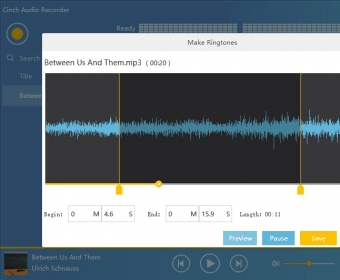

CINCH AUDIO RECORDER SAFETY SOFTWARE
Integration of FDAU functions into software required by other aircraft system components is now being seen, as in the case of the Enhanced Airborne Flight Recorder (EAFR) installed on the Boeing 787. Information from the FDAU to the FDR is sent via specific data frames, which depend on the aircraft manufacturer. A flight-data acquisition unit is a unit that receives various discrete, analog and digital parameters from a number of sensors and avionic systems and then routes them to a flight data recorder (FDR) and, if installed, to a Quick Access Recorder (QAR). The solution was development of the flight data acquisition unit (FDAU).

Second-generation FDRs were introduced in the 1970s as the requirement to record more data increased, but they were unable to process the larger amounts of incoming sensor data. Beginning in 1965, FDRs (commonly known as "black boxes") were required to be painted bright orange or bright yellow, making them easier to locate at a crash site. This metal foil was housed in a crash- survivable box installed in the aft end of an airplane. Many first-generation FDRs used metal foil as the recording medium. Evaluating the data could be useful in making a decision to replace the engine before a failure occurs.įigure 1: Flight Data Recorder, Source: Historyįlight data recorders were first introduced in the 1950s. An example of the latter is using FDR data to monitor the condition of a high-hours engine. Furthermore, these data have contributed to airplane system design improvements and the ability to predict potential difficulties as airplanes age. The data collected in the FDR system can help investigators determine whether an accident was caused by pilot error, by an external event (such as windshear), or by an airplane system problem. The recorder is installed in the most crash survivable part of the aircraft, usually the tail section. I states that, all aeroplanes of a maximum certificated take-off mass of over 5,700 kg for which the individual certificate of airworthiness is first issued after 1 January 2005 shall be equipped with a Type IA FDR.Īccording to ICAO SARPS, combination recorders (FDR/CVR) can only be used to meet the flight recorder equipage requirements as specifically indicated in ICAO Annex 6 (Vol I and Vol III, Attachment D). For example, provision 6.3.6 of Annex 6, Vol.

Furthermore, provisions in section 6.3 specify the aircraft equipage requirements depending on the maximum certificated take-off mass and the date of first issue of the individual certificate of airworthiness. The detailed list of parameters to be recorded by FDRs is provided in section 6.3 “Flight recorders” and at Attachement D to Annex 6, Vol. Types II and IIA FDRs shall record the parameters required to determine accurately the aeroplane flight path, speed, attitude, engine power and configuration of lift and drag devices. III, a Type I FDR shall shall record the parameters required to determine accurately the aeroplane flight path, speed, attitude, engine power, configuration and operation. ICAO RequirementsĪccording to the provisions in ICAO Annex 6 - Operation of Aircraft, Vol 1 and Vol. Combination recorders need to meet the flight recorder equipage requirements as specifically detailed in ICAO Annex 6 - Operation of Aircraft. Where both types of recorder are fitted, they are now sometimes combined into a single unit (ICAO Definition: Combination recorders). The purpose of an FDR is to collect and record data from a variety of aircraft sensors onto a medium designed to survive an accident.Īn FDR has historically been one of two types of "flight recorder" carried on aircraft, the other being a cockpit voice recorder (CVR). Flight Data Recorder (FDR) - device used to record specific aircraft performance parameters.


 0 kommentar(er)
0 kommentar(er)
